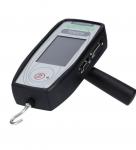This article is a summary of Dr Mario Walther's doctoral thesis (see sources below in German).
Assembly forces applied in production can represent risk factors and contribute to the development of health disorders. This risk increases considerably with age and can therefore increase absenteeism due to illness. In addition, companies that do not implement ergonomic measures must also pay the high costs.
It is therefore important to give priority to people and their health by recognizing and eliminating risk factors at an early stage!
In order to measure these assembly forces in a practical way with human influence and to perform effective measurements, the intervention of ergonomists in the workplace with force measuring instruments is recommended. These measures provide objective, detailed and accurate results of the human body's stress variables. To do this, ergonomists need the most accurate measuring instruments.
High forces applied by hand
It is in production and more specifically in the assembly area that the greatest number of actions involving manual force are carried out. The assembly of quick couplings, connectors and coatings is associated with repetitive and high hand and finger forces and represents a fairly high risk for installers. High assembly forces, poor posture and insufficient rest periods can be harmful to health. The dimensions and material of the joints also play a decisive role in the application of force.Early consideration of ergonomic aspects can lead to improvement measures that can reduce or prevent risk factors. For example, companies can significantly reduce the assembly forces required by developing components that are easy to assemble during the design phase, and workstations and tools can be designed more ergonomically.
To take these ergonomic elements into account, it is necessary to carry out practical measurements that first and foremost define the actual assembly force.
Why does the assembly force not correspond to the impact force?
It is important to distinguish the joining force from the impact force. The assembly force is the force required to assemble a component. The force exerted by the assembler after insertion is the impact force or holding force. Due to the short time available to a fitter for his task, it is often impossible for him to reduce his efforts sufficiently. When the force exerted approaches the force to be exerted, the work is performed efficiently. Otherwise, the effort may lead to the assembler's illness.
If a force gauge is used for ergonomic measurement, which only measures the maximum, it is not the assembly force but the impact force that is determined. The assembly forces involve high-frequency vibrations in the order of 250 Hz: a measurement frequency that is too low does not allow the difference between the assembly force and the impact force to be determined due to the rapid assembly method. This leads to a lack of feedback on the assembly process and can lead to the application of greater force.
The solution: the force gauge Centor Touch
The force gauge Centor Touch from Andilog is a flexible and sophisticated solution for practical measurements in production areas. This economical, robust and highly accurate force gauge is equipped with strain gauges and allows fast measurements without disrupting work processes.The Centor Touch measures at a sampling rate of 5000 Hz, which allows the smallest force fluctuations to be measured. It offers automatic calculations such as the first break (joining force) and the maximum of the complete test (impact force or holding force). The curve is displayed on the screen in real time, which allows the assembler to judge whether it was correctly performed immediately after the measurement. Adjustable force thresholds in the Centor Touch allow the user to enter the force to be applied: an acoustic signal indicates to the assembler when the desired value has been reached and he can stop the measurement.
As the direction of the force influences the measurement, Andilog has developed small pressure plates (Ø20 and 8 mm), which help the person who is testing in his measurement on the ideal junction axis. The values determined are very accurate and the calibration certificate provided guarantees an accuracy of 0.1% over the entire measuring range of the sensor.

Results of measurements with the Centor Touch
The Centor Touch offers a very good price/quality ratio with a realistic test speed. The measurement starts manually after the application of a previously defined force and ends automatically after a defined period of time.The touch screen displays the two necessary forces calculated at 5000 Hz, which each ergonomist wishes to analyze: the assembly and impact forces. The determined curve can be compared to the target curve and if it is correct, the curve points can be saved on a USB stick.
In the Datastick II computer software, it is possible to mark the 4 phases of the assembly - increase in force, assembly force, pressure and force drop - and export them in reports. Ergonomics managers can thus increase the acceptance of ergonomic measures in the company thanks to precise and objective results.
Conclusion
Ergonomics is the result of collaboration between all the departments and partners of a company. It plays an essential role in the process of making people the company's main resource and restoring their health and value creation potential. Andilog also considers itself to be an actor and partner in this field.
Source: Mario Walther, 2015, "Development and evaluation of a systematic procedure for recording action forces in automobile production", Entwicklung und Evaluierung eines systematischen Vorgehens zur Erfassung von Aktionskräften in der Automobilproduktion, genehmigte Dissertation zur Erlangung des akademischen Grades Doktor-Ingenieur, Fakultät für Maschinenbau der Technischen Universität Chemnitz
Document available in german on the website qucosa.
